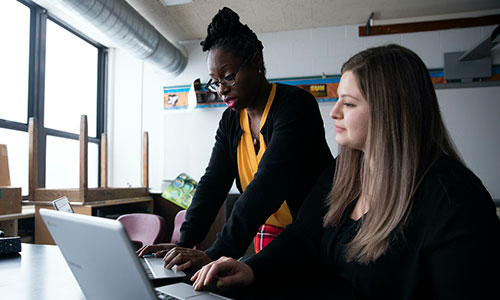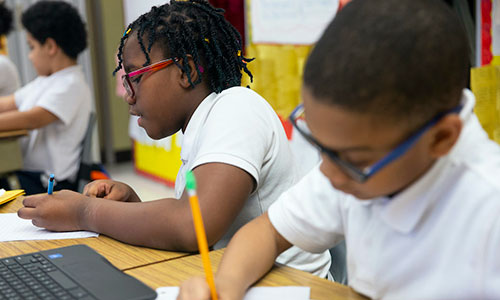
We don’t talk enough about educator mindsets.
Early in my teaching career, I taught an English class where all the students were three or more years below grade level. I thought this meant that I should teach the skills they were missing with lower-level texts. During a professional development session, I got feedback from a fellow teacher who argued the opposite. “I know your students have some challenges with grade-level work,” she began. “But if you don’t think they’re capable and you never give them access to rigorous work, you’re limiting their growth potential.”
This colleague’s feedback sparked me to reflect on my practices. I realized I was operating with the mindset that my students were incapable of completing assignments at their grade level. My mindset fueled the instructional decisions—decisions I made—that were hindering my students’ success. I thought that I was meeting them where they were when, really, I was just holding them down.
Educator mindsets as a part of educational equity
At NWEA, we define mindsets as “a set of mental attitudes that determine how one will interpret and respond to situations.” These mental attitudes can also be described as beliefs or assumptions, and they impact educators’ approach to content, pedagogy, instructional decisions, and much more.
The power of mindsets is precisely why they are a critical part of our Six Entry Points for Equity framework, as detailed in our “Equity statement.” The entry points for equity—mindsets, relationships, products, spaces, processes, and systems—are starting points for ensuring that academic success is a nonnegotiable for all students. Educator mindsets have a profound impact on teaching and learning.
What inequitable mindsets look like
Equitable mindsets are critical to ensuring an excellent education. Unfortunately, as Kristyn Klei Borrero says in Every Student, Every Day, many educators knowingly or unknowingly hold mindsets that can be harmful to their students. This harm to students, she explains, is “immeasurable, as it reflects the larger deficit narrative that much of the education system harbors.”
Examples of inequitable mindsets are reflected in the following statements:
- “These students aren’t interested in learning.”
- “My first period class is so bad.”
- “Intelligence is fixed.”
- “James isn’t a math person, so a C is as high as he can go in my algebra class.”
Inequitable mindsets are displayed in subtle—yet harmful—actions, too, such as calling on certain students less, asking fewer challenging questions, and rewarding students for less rigorous answers.
A teacher’s inequitable mindset can negatively shape students’ own mindsets about their academic performance. Students hear the messages that convey our thoughts about their abilities. The worst part is, they may not realize they’re internalizing our negativity, and our opinions of them may follow them for the remainder of their academic careers.
Know your mindset
Research has long proven that educator mindsets matter and can impact student performance. As Seth Gershenson et al. explain in “Who believes in me? The effect of student-teacher demographic match on teacher expectations,” “In a famous experiment, Rosenthal and Jacobson (1968) manipulated teachers’ beliefs of student ability by providing false information regarding students’ performance on a nonexistent test and found significantly greater school-year gains among the students who were falsely identified to teachers as ‘growth spurters.’”
No one has a perfect mindset, of course, and as educators, we all enter the field of teaching with years of cultural beliefs, values, and biases that impact our decision-making. But as Klei Borrero also says, these deficit mindsets become more pronounced when educators don’t reflect on how their beliefs influence their actions.
Here are some questions you can use to reflect on and better understand your mindset:
- What do I believe about my students?
- Is my mindset inherited from someone or somewhere?
- Is my mindset rooted in assumptions or facts?
- What outside factors or identities influence my mindset?
- Do the outside factors or identities influencing me contain clues to any unconscious or conscious biases?
- Does my mindset create or remove barriers for students?
Reflecting on your mindset can feel like hard work. That’s because it is. It requires you to hold up a mirror to yourself, your upbringing, and your belief system. However, this step is essential for unlearning what you may have grown to believe are universal truths.
Reflecting is also a journey that never really ends, but the more you do it, the more you’re able to identify patterns and make connections, which can help you serve all your students.
Take action
Identifying inequitable mindsets is the first step. Working to reframe them comes next.
My colleague Fenesha Hubbard, design coordinator for equity professional learning at NWEA, offers a guide to reframing mindsets in her upcoming book, The Equity Expression: Six Entry Points for Nonnegotiable Academic Success. She believes there are four steps for reframing educator mindsets:
- Name the issue.
- Assume good intent.
- Identify the needs.
- Reframe the issue.
With reflection and reframing, a mindset like “these students are incapable of completing grade-level work” can transform into “with the right scaffolds and support, these students can access grade-level work.” I know that when Ioperated with that reframed mindset, my students achieved more and the confidence I had in them rubbed off on them.
An equitable education cannot happen without deep reflection—and interrogation—of mindsets. Students deserve educators who are constantly reflecting on their mindsets and seeking ways to improve their practice.
For more information on educator mindsets and other entry points to equity, check out The Equity Expression: Six Entry Points for Nonnegotiable Academic Success and our professional learning workshop series on creating supportive environments. To learn more about equitable practices in reading instruction in particular, consider “Let’s talk equity: Reading levels, scaffolds, and grade-level text.”






